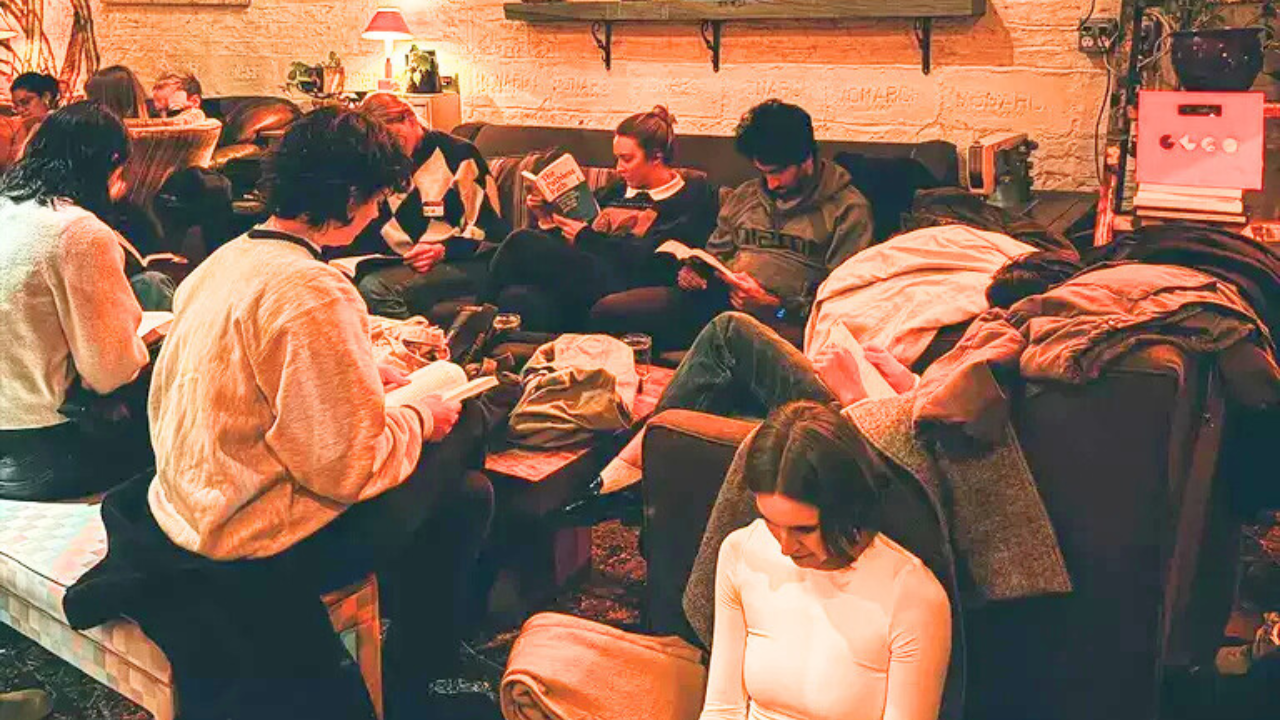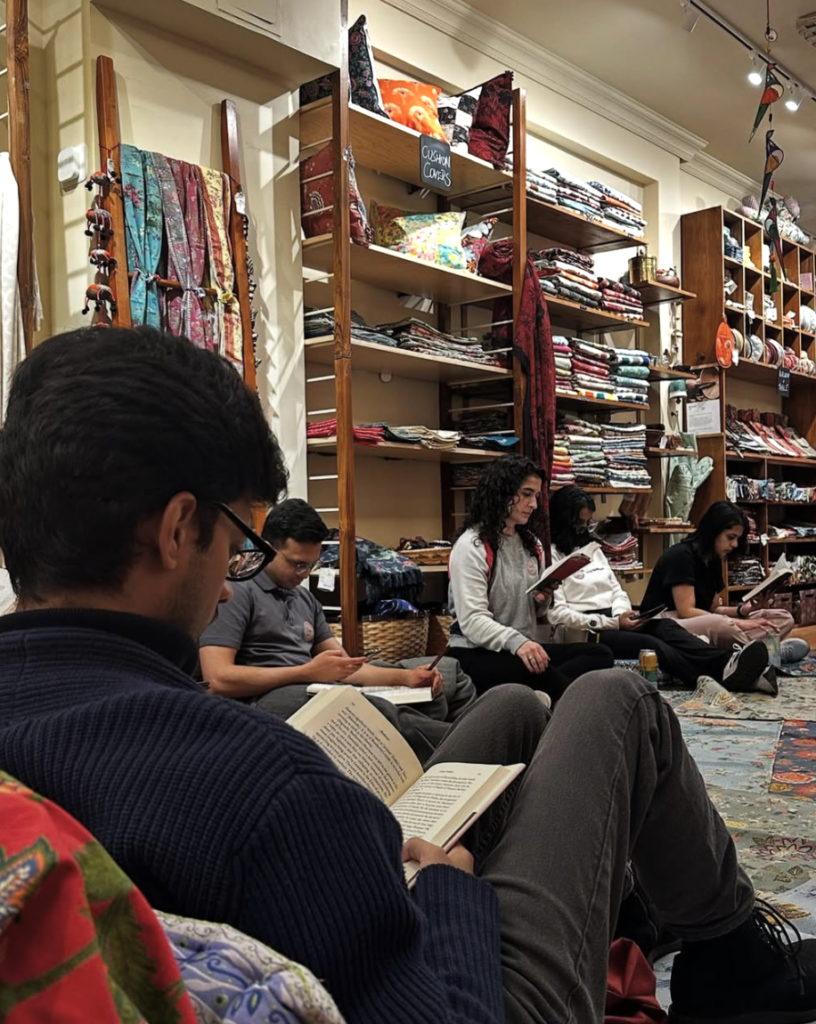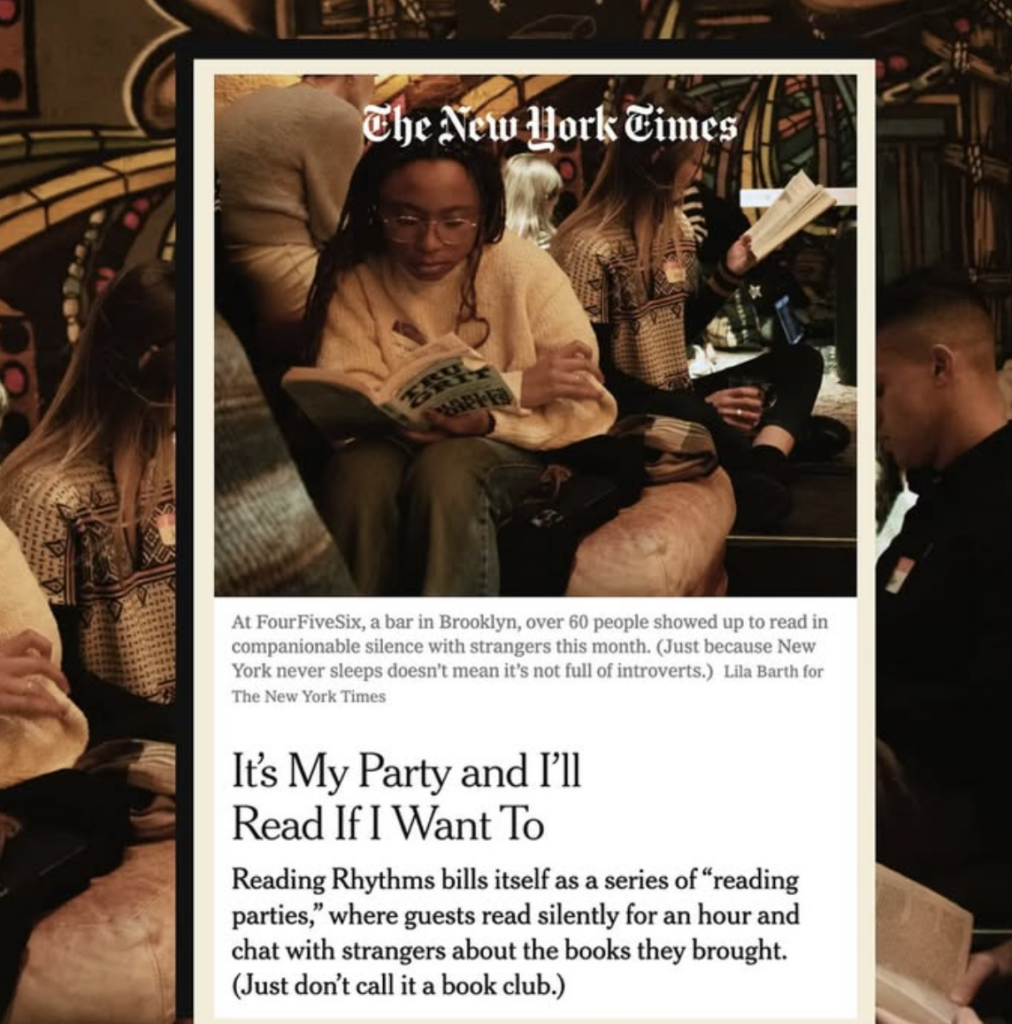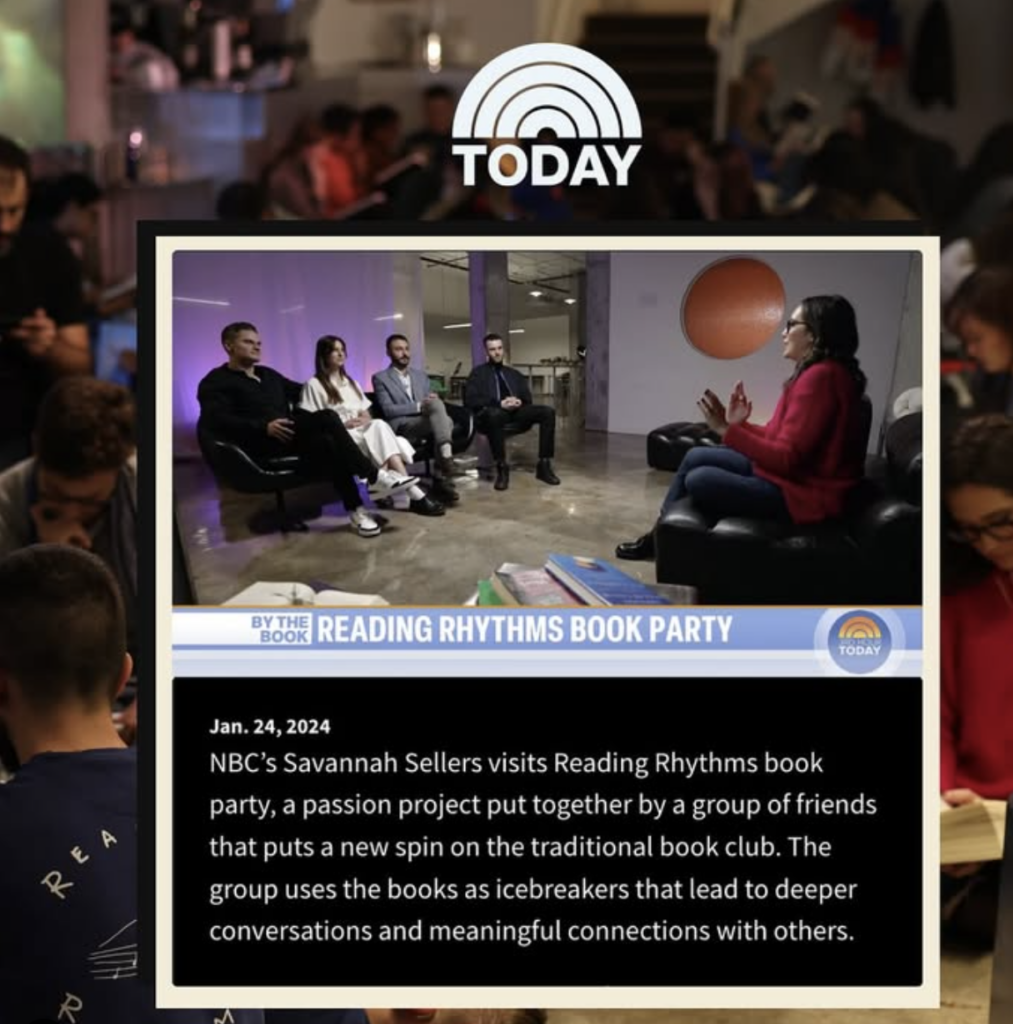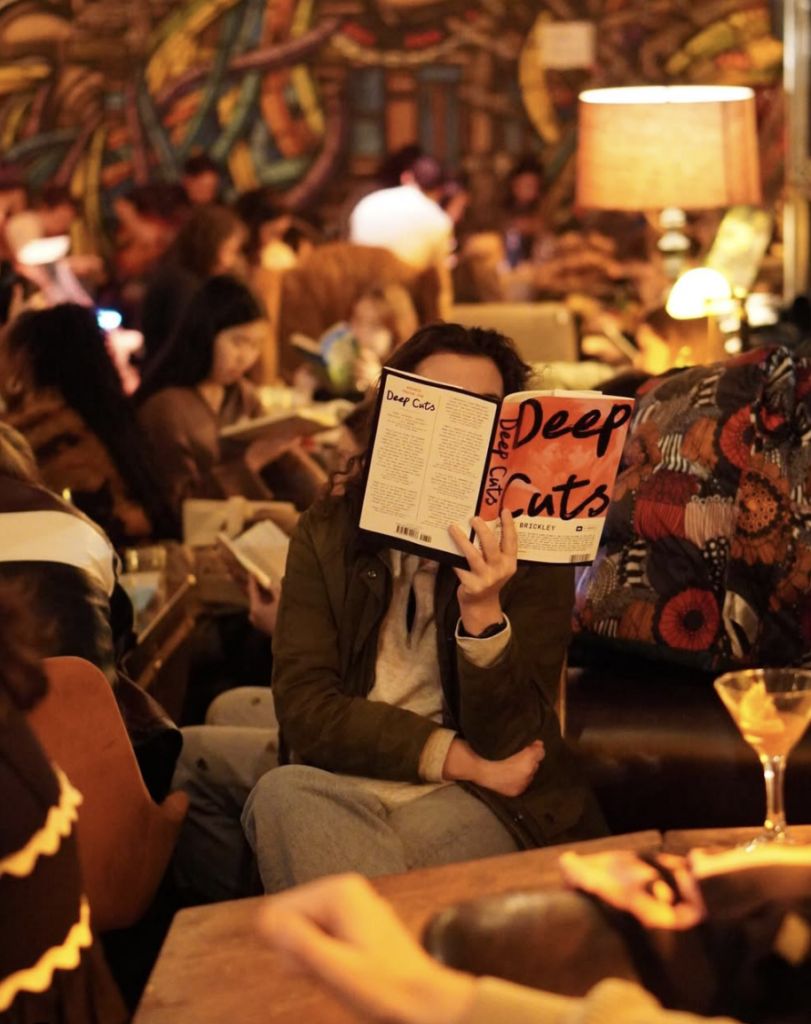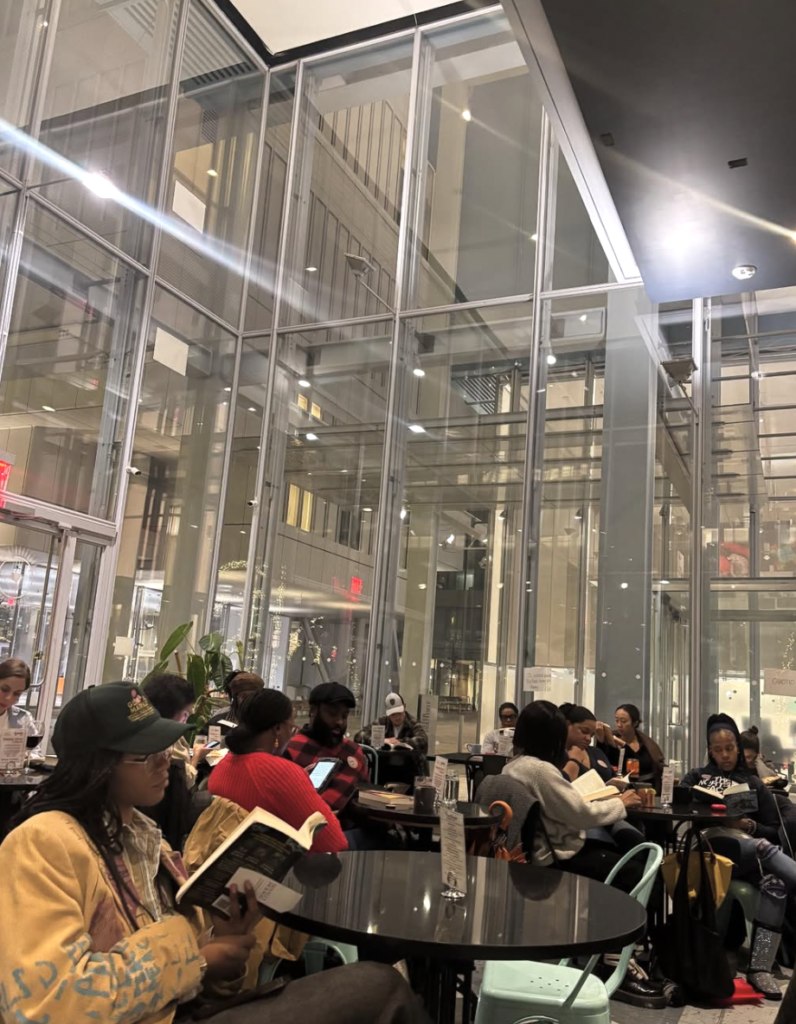Reading Rhythms isn’t a book club… but I bet a lot of people think it is.
That’s their tongue-in-cheek tagline, and for good reason. Unlike traditional book clubs, where everyone reads the same book, at Reading Rhythms, you bring whatever you’re currently reading. Fiction one day, nonfiction the next? No problem – bring both and you’ll be welcome.
While they share similarities with book clubs (in-person gatherings for readers), they differ in one crucial way: they don’t tell you what to read.
How a Reading Party Actually Works
If you’re curious about the Reading Rhythms experience, here’s the rundown:
You show up with your own book and get a cute branded name tag. Then you dive into your first 30-minute reading block while curated music plays softly in the background, hence the name “Reading Rhythms”. (It started as a Spotify playlist.)
After reading, there’s a 15-minute one-on-one discussion period where your book becomes the perfect icebreaker. As founder Ben Bradbury says:
“My favorite question for any reader isn’t ‘What do you do for work?’ It’s ‘What are you reading?’ Because the lights in your eyes will light up… and if I like that book, we’re about to have a great conversation.”
Following the discussions, everyone gets another 30 minutes of quiet reading time before ending with 20 minutes of group discussion around themes related to the night.
All in all, it’s about two hours – part solitude, part socializing, with some great book recommendations as a bonus.
From Dusty Bookshelves to The New York Times
The concept was born around 18 months ago when Ben was living in New York City with his best friend Tom. They realized their books were gathering dust on the shelves because they were too busy being “classic New Yorkers” and always out socializing.
The lightbulb moment came when Tom suggested doing an event centered around books. They started brainstorming:
“What if we had time where we could read by ourselves and time to meet other people?”
It felt like a book club but different… cooler. With access to a great Brooklyn rooftop and a desire to create a vibe, they dubbed it a “reading party.”
Their first event hosted just 10 friends on their rooftop with nice lighting and snacks. For four or five months, it remained a fun hobby project. Then something unexpected happened. They got covered by the New York Times.
The coverage was “completely honestly life-changing” according to Ben. Suddenly, people from six continents were reaching out, wanting Reading Rhythms in Sydney, Guadalajara, Algeria, Rome, and beyond.
Eighteen months later, they’re in 15 cities, working to create belonging through reading.
How They Landed The New York Times
The New York Times feature came through community connections. A regular attendee named Adam was good friends with Molly, who worked at the Times. After hearing about the concept, Molly thought it sounded unique and came to experience a reading party herself.
Ben recounts the surprising moment when it all went public. He had flown home for Christmas, and jet-lagged on December 19th, received an unexpected email from Molly:
“Editorial loved your piece. Great news, and we’re going live later today. We’ll see you in two hours. Good luck.”
After the article dropped at 5 PM Eastern time, everything went nuts. Major publishers reached out. The Today Show wanted to feature them. Brands wanted to send products.
Ben remembers thinking, “I don’t think this is a hobby anymore. I think this is a real thing.”
The Business Model Goes From Free to Franchise-ish
Initially, Reading Rhythms was completely free. The first event had 10 people, who told their friends, growing the attendance to 20. Around the fourth or fifth event, they “sold out” the roof with a capacity of 30, but only half the people showed up.
That taught them an important lesson about free ticket models: without commitment, many registered attendees won’t show. After much deliberation, they decided to charge a nominal fee ($15-$20 in the United States) to raise attendee commitment.
Ben compares it to a yoga class.
“You go for an amazing space that isn’t doing yoga in your living room. You go for an instructor who’s trained and knows the format to guide you through. And you go for a format that you don’t have to memorize and can just be led through.”
Reading Rhythms offers similar value – intentionally selected venues, trained facilitators who go through an onboarding program, and a signature format that feels consistent whether you’re at a reading party in Charleston, Toronto, or Florence.
Beyond ticket sales, they partner with publishers and brands looking to get new titles in front of aligned readers. They’ve worked with or had conversations with all “Big Five” publishers.
Building Local Reading Communities
For those wondering how Reading Rhythms has expanded so quickly, their approach is similar to a franchise model, but more community-focused. Ben calls it a “chapter in a box” model.
Unlike traditional franchises (which can cost $50K+ just for documentation), Reading Rhythms looks for aligned readers with a passion for building local reading communities. They want “fire starters” – people who can organize, find venues, and corral readers.
Ben believes that “community is cadence”. You need regular touchpoints to build community. Their recommendation to chapter leads is to host reading parties monthly, which seems to be the sweet spot for most readers (though some attend bi-weekly).
The Reading Rhythms team provides significant backend support, sharing their playbook on marketing, operations, and venue sourcing. They focus on three key elements that readers want:
- Convenient venues (easily accessible in your area)
- Local hosts (who match the neighborhood)
- Local readers (creating community connections)
This local focus has created an unexpected phenomenon – tourists from Brazil, Italy, Sweden, and Norway putting Reading Rhythms on their New York bucket list, then returning home to start chapters in their own cities.
Behind the Scenes: From Hobby to Full-Time Gig
Running Reading Rhythms is now Ben’s full-time job – something he never would have predicted.
“If you asked me two years ago what I’d be doing and I said, ‘I’m professionally throwing reading parties,’ I would’ve been like, ‘Get outta here! What even is that?’ But the world works in mysterious and beautiful ways.”
He emphasizes that it’s not a one-person show but a team effort with co-founders (and best friends) John, Tom, and Charlotte, plus backend support for sales, marketing, account management, reader support, product, and operations.
Ben still attends many reading parties, keeping name tag stickers from each event across his desk (approaching 50 at this point). He believes that “working behind a screen is no substitute for the real impact that we make” and loves being reminded of the positive difference they’re creating.
Advice for Turning a Bookish Hobby into a Business
Ben’s advice for others looking to turn their bookish hobbies into businesses starts with a question:
“What feels like play to you that feels like work to everybody else?”
He believes life’s joy comes from finding “a game that you want to play for the love of playing it,” that you find easy while everyone else finds it hard. Trust your instincts about what makes you happy.
For example, he mentions a Chicago chapter lead named Sarah who loves bookbinding. Rather than forcing her passion into an ill-fitting business model, he suggests she continue creating amazing bound books and document her journey, perhaps through a social media series.
The key is figuring out your series and sharing it authentically, allowing others to get bought into your excitement.
Ben’s Book Recommendations
Currently on Ben’s nightstand is The DragonBone Chair by Tad Williams – one of his favorite genres, high fantasy. He just started it the night before the interview, and notes it’s one of the original epic fantasy sagas that inspired George R.R. Martin to write Game of Thrones.
His recent can’t-put-down read was Pierce Brown’s Red Rising Trilogy, particularly the second book, Golden Son. After hosting their first global reading party in Italy, all Ben wanted to do was get back to the book.
“I was like, ‘Yeah, yeah, yeah, this is cool, but what’s happening on chapter 35? I gotta find this out!'”
Looking to join a reading party in your area? Visit readingrhythms.co and fill out their form to bring Reading Rhythms to your community.
